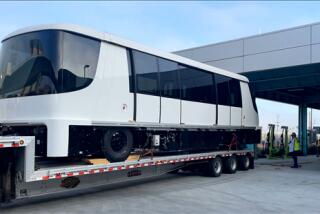Shanghai Making Tracks for Ultra-High-Speed Connection
SHANGHAI — Other countries said no. But China said yes. So the world’s fastest passenger train will have its commercial maiden voyage here in the Middle Kingdom’s cutting-edge city in 2003.
The Chinese government signed a $2-billion deal with Transrapid International, a German consortium, in late January. The magnetically levitated, or “maglev,” train will connect Shanghai’s Pudong business district with its new airport, an 18-mile ride that takes about 45 minutes by car. With the new system, it will take seven minutes.
The German companies are overjoyed to find a taker for their 30-year-old technology. Europe has turned down many proposals for commercial projects. Response from the United States also has been lukewarm, although early this year, the federal government agreed to fund two feasibility studies.
All eyes will be on the Shanghai test run.
“The Shanghai project is of key importance, not only for the Chinese market but also for Transrapid installations worldwide,” said Peter Wiegelmann, Transrapid’s spokesman in Germany. “We believe that a go-ahead from the Chinese will give added stimulus to studies currently taking place, for example, in the USA.”
Chinese officials are hoping for commercial success that will help justify investing in a longer, more expensive high-speed line between Shanghai and Beijing. The 812-mile journey takes about 18 hours by regular train and about 2 1/2 hours by air. The Transrapid would take about three hours.
Shanghai Mayor Xu Kuangdi said cost and speed were major factors in choosing the technology. His predecessor, Zhu Rongji, who is now China’s premier, was so in awe of the train that he personally helped facilitate the negotiations and persuade naysayers to support the project.
Work has already begun. Ground has been broken, and authorities are relocating the relatively few people who live in what would be the train’s path.
Officials project usage at 10 million rides per year by 2005 and a fare of $6.
Although the year-old Pudong airport is having trouble luring customers from the old Hongqiao airport, project officials say that will change with the arrival of the high-speed train.
Eventually, the annual passenger traffic at Pudong is expected to swell to 70 million, making it one of the biggest airports in Asia.
The idea for maglev technology--increasing speed by reducing friction on tracks--is a century old. The train floats above ground and is able to travel up to 300 mph, making it a formidable challenger to automobiles and aircraft.
The U.S. Department of Transportation in January chose Pittsburgh and the Washington-Baltimore area as finalists in the contest to win federal funds for pilot projects.
Germany and Japan have researched the technology and developed prototypes for high-speed trains, but they never have been put into full production. A planned link between Hamburg and Berlin was scrapped because of concerns about cost, profitability and the environment.
Chinese skeptics had similar worries. But their voices were drowned out by optimists who believe that the train’s benefits outweigh its costs.
“This train can save us between 20% to 30% in energy costs,” said Shao Bingheng, an engineering professor at Shanghai’s Tong Ji University. “Its noise output is supposed to be minimal relative to its speed. Its air and water pollution is basically zero. Shanghai is a great place to run this test model. We can show the whole country what it is and how it works.”
The Transrapid International comprises ThyssenKrupp and Siemens. On the Chinese side, the government is represented by a consortium of six corporations based in Shanghai. The German government offered a subsidy of about $94.9 million to the German companies involved in the project.
The Shanghai government is getting a loan of 100 million marks--about $47 million--from the German government.
More to Read
Sign up for Essential California
The most important California stories and recommendations in your inbox every morning.
You may occasionally receive promotional content from the Los Angeles Times.










